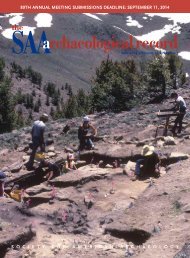SAA
SAA_Record_Nov2015
SAA_Record_Nov2015
Create successful ePaper yourself
Turn your PDF publications into a flip-book with our unique Google optimized e-Paper software.
PROS AND CONS OF CONSULTING COLLECTORS<br />
THE PRESENT AND FUTURE OF<br />
ARCHAEOLOGIST-COLLECTOR<br />
COLLABORATION<br />
Bonnie Pitblado and Michael J. Shott<br />
Bonnie Pitblado is in the Department of Anthropology, University of Oklahoma, Norman, Oklahoma.<br />
Michael J. Shott is on the Department of Anthropology & Classical Studies, University of Akron, Akron, Ohio.<br />
In this concluding essay, we do two things. First, we<br />
explore the diverse contributions to this issue of The <strong>SAA</strong><br />
Archaeological Record to identify points of divergence and<br />
common ground. Second, we offer suggestions for translating<br />
consensus ideas into proactive steps that individual<br />
archaeologists and <strong>SAA</strong> can take to promote responsible collaboration<br />
and improve stewardship of the physical archaeological<br />
record, including that portion currently in private<br />
hands.<br />
Reconciling the Views of The <strong>SAA</strong> Archaeological<br />
Record Contributors<br />
Broadly, contributors to this issue of The <strong>SAA</strong> Archaeological<br />
Record (tSAR) appear to operate from one of two very different<br />
worldviews. For some (e.g., Cox, Connolly, and Childs),<br />
the foundation for evaluating whether and how archaeologists<br />
should collaborate with collectors is rooted in what they<br />
see as the realities of the U.S. legal system, archaeological<br />
ethics, and human behavior. For others (e.g., Goebel and, to<br />
a lesser extent, Watkins), a sense of what our nation should<br />
be (one without an imperialistic past, with stronger heritage<br />
laws, where only trained archaeologists indulge the urge to<br />
collect, and where collectors are not already having a profound<br />
impact on archaeological landscapes) shapes their<br />
interactions— or lack thereof— with artifact collectors.<br />
We believe the distinction accounts for why equally accomplished<br />
and ethical archaeologists sometimes approach<br />
prospective collaboration entirely differently. Accepting our<br />
nation, its laws, and its people as they are— even when we<br />
perceive any or all of those elements as flawed— creates<br />
space for collaboration. Operating from a foundation of how<br />
the U.S. past and present population should be accentuates<br />
flaws, often turning them into collaborative deal-breakers.<br />
Neither worldview is inherently right or wrong. However,<br />
conscious reflection upon one’s ethos may help illuminate<br />
one’s own base comfort level with professional-collector<br />
interaction, while demystifying positions colleagues hold on<br />
the subject.<br />
We also learned from our contributors just how blurry the<br />
lines can be among professional archaeologists, avocational<br />
archaeologists, and collectors. In fact, as Cox points out (and<br />
exemplifies) in his essay, many people move fluidly among<br />
these categories during their lifetime. Spurning all collectors<br />
today will likely burn bridges with future colleagues or<br />
knowledgeable and dedicated avocationals who stop collecting<br />
after learning about satisfying alternatives. Relatedly, definitions<br />
of what many tSAR readers likely see as straightforward<br />
terms— notably “avocational archaeologist” and “collector”—carry<br />
substantively different meanings and connotations<br />
when invoked by one archaeologist (or avocational or<br />
collector) versus another. Like individual worldview, this likely<br />
helps explain why archaeologists struggle to achieve consensus<br />
about whether and how to interact with “artifact collectors.”<br />
Continuing with the theme of “ambiguity,” tSAR contributors,<br />
including ourselves, have different takes on how much<br />
collecting has gone on over the past hundred years or so;<br />
how much of it falls into the category of large-scale looting<br />
(e.g., backhoe plundering of mound villages) versus welldocumented<br />
surface collecting; how collecting varies based<br />
on regional norms; the nature of damage various forms of<br />
collecting have on the archaeological record; and the extent<br />
to which collaboration can mitigate that damage. To our<br />
knowledge, no one has studied any of these subjects systematically,<br />
which leaves each of us to answer these questions<br />
based only on our own experiences. Those experiences vary<br />
enormously (witness the essays and contrasting conclusions<br />
of Connolly versus Goebel), leading to yet another reason<br />
why some of us strongly advocate collaboration while others<br />
are more leery of or outright reject the practice.<br />
36 The <strong>SAA</strong> Archaeological Record • November 2015




